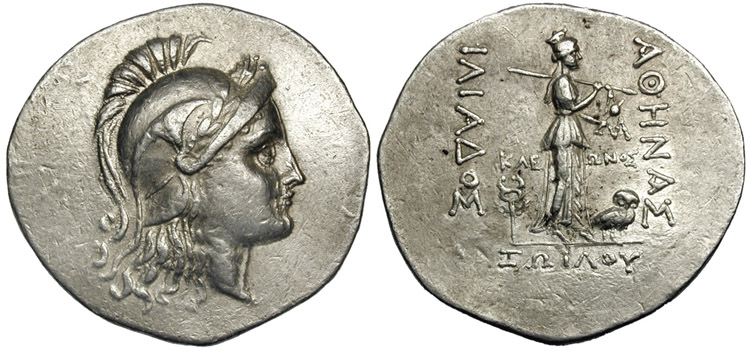 This postcard sent to me by Cuneyt
This postcard sent to me by Cuneyt Silver tetradrachm from Troy during the Hellenistic period, 188–160 BC. Head of Athena in Attic helmet. Reverse female figure and owl with inscription: ΑΘΗΝΑΣ ΙΛΙΑΔΟΣ, ΚΛΕΩΝΟΣ ΙΛΙΟΥ, "Athénas Iliados, kleōnos Iliou".
Silver tetradrachm from Troy during the Hellenistic period, 188–160 BC. Head of Athena in Attic helmet. Reverse female figure and owl with inscription: ΑΘΗΝΑΣ ΙΛΙΑΔΟΣ, ΚΛΕΩΝΟΣ ΙΛΙΟΥ, "Athénas Iliados, kleōnos Iliou".A new city of Ilium was founded on the site in the reign of the Roman Emperor Augustus. It flourished until the establishment of Constantinople and declined gradually during the Byzantine era.
In 1865 an English archaeologist, Frank Calvert, excavated trial trenches in a field he had bought from a local farmer at Hisarlık, near Truva and in 1868 a wealthy German businessman, Heinrich Schliemann, after a chance meeting between the two men in Çanakkale town, also began excavating in this area.[2][3] Later excavations revealed several cities built in succession to each other. One of the earlier cities (Troy VII) is generally identified with Homeric Troy. While such an identity is disputed, the site has been successfully identified with the city called Wilusa in Hittite texts; Ilion (which goes back to earlier Wilion with a digamma) is thought to be the Greek rendition of that name. Read more
The archaeological site of Troy was added to the UNESCO World Heritage list in 1998.
Information and Image Obtained From Wikipedia, the free encyclopedia
No comments:
Post a Comment